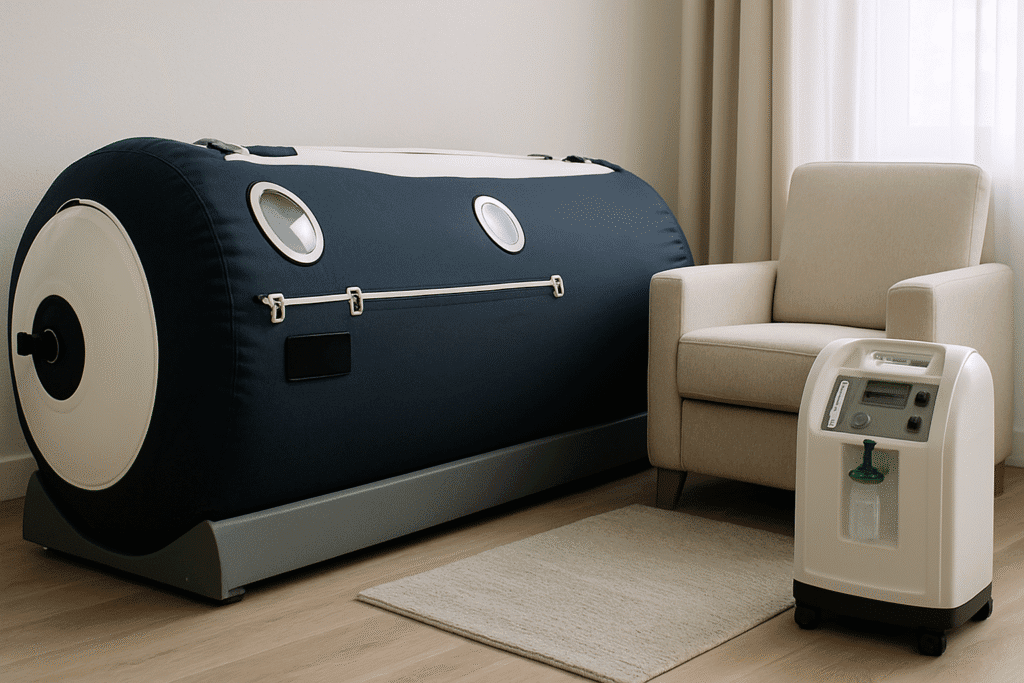When you hear “hyperbaric chamber,” you probably picture a diver with the bends or some pro athlete trying to recover faster. But here’s the thing — hyperbaric oxygen therapy (HBOT) isn’t just for the elite. It’s about oxygen, the one thing you literally can’t live without, used in a way most of us never get.

Oxygen: The Fuel We Forget About
We can skip food for weeks, water for days… but oxygen? A few minutes and that’s it. Every single cell runs on it. Your mitochondria — the little power plants in your cells — need it to make energy.
When they don’t get enough, your cells panic. They start fermenting sugar instead of burning fat efficiently. That’s when inflammation creeps in, energy tanks, and healing slows to a crawl.
HBOT flips that. Inside the chamber, you’re breathing pure oxygen under pressure. That combo forces oxygen deeper into your tissues — even into spots that normally get ignored.
What’s Really Going On in There
Under pressure, oxygen behaves differently. It doesn’t just ride along on red blood cells like normal — it dissolves into your plasma. Think of it like upgrading your blood to carry way more oxygen than usual.
Here’s what that means:
- Starved cells finally get fed.
- Mitochondria switch back to clean energy.
- Inflammation dials down.
- Healing speeds up — from wounds to sore muscles.
Why People Are Using It
- Athletes → LeBron James, Novak Djokovic, and tons of others use it for faster recovery.
- Brain health → Studies are testing HBOT for concussions, traumatic brain injury, PTSD, and even early Alzheimer’s.
- Chronic illness → Clinics use it for Lyme, long COVID, radiation injury, and other stubborn conditions.
- Longevity → Biohackers call it “oxygen fasting,” a way to train cells to be tougher and age better.
Why This Actually Makes Sense
Our ancestors lived in fresh, oxygen-rich environments. No cars, no pollution, no sitting indoors all day. Today, we breathe stale air under artificial lights and wonder why we feel half alive. HBOT feels like a way to reset — giving our cells the oxygen they’ve been missing.
How to Get Started
- Hospitals → Big chambers for medical conditions doctors already approve.
- Wellness clinics → Smaller “mild” chambers popping up everywhere now.
- At-home setups → Portable chambers exist, but if you’re new, start with guidance.
Sessions usually run 60–90 minutes, a few times per week. Price depends on the setup, but results can be massive if your body needs the boost.
HBOT isn’t some magic fix. But it’s powerful. To me, it’s less about chasing a trend and more about reminding your body how to thrive. Pair it with real food, sunlight, quality sleep, and less stress, and you’ve got a foundation that’s hard to shake.
Health isn’t random. It’s about creating the right environment so your body can actually do what it was designed to do. Hyperbaric oxygen therapy? It’s just one of the tools helping us get there.
Sources
- Thom, S.R. Hyperbaric Oxygen: Its Mechanisms and Efficacy. Plast Reconstr Surg (2011).
- Harch, P.G. Hyperbaric Oxygen Therapy in Global Cerebral Ischemia. Neurocrit Care (2015).
- Hyperbaric Oxygen Therapy and Mitochondrial Function. Frontiers in Medicine (2022).

Leave a Reply